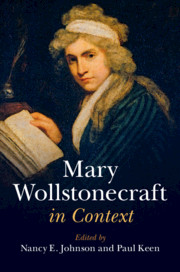Book contents
- Mary Wollstonecraft in Context
- Mary Wollstonecraft in Context
- Copyright page
- Contents
- Illustrations
- Notes on Contributors
- Preface
- Frontispiece
- Chronology
- Part I Life and Works
- Part II Critical Fortunes
- Chapter 5 Early Critical Reception
- Chapter 6 Nineteenth-Century Critical Reception
- Chapter 7 1970s Critical Reception
- Chapter 8 Recent Critical Reception
- Part III Historical and Cultural Contexts
- Suggested Further Reading
- Index
Chapter 8 - Recent Critical Reception
from Part II - Critical Fortunes
Published online by Cambridge University Press: 16 January 2020
- Mary Wollstonecraft in Context
- Mary Wollstonecraft in Context
- Copyright page
- Contents
- Illustrations
- Notes on Contributors
- Preface
- Frontispiece
- Chronology
- Part I Life and Works
- Part II Critical Fortunes
- Chapter 5 Early Critical Reception
- Chapter 6 Nineteenth-Century Critical Reception
- Chapter 7 1970s Critical Reception
- Chapter 8 Recent Critical Reception
- Part III Historical and Cultural Contexts
- Suggested Further Reading
- Index
Summary
Wollstonecraft’s life and writings have attracted increasing critical attention in recent years, with a considerable broadening of topics and themes positioning Wollstonecraft’s work in a number of new ways. Certain patterns have emerged. Critics like Anne K. Mellor, Tilottama Rajan, Claudia L. Johnson, and Harriet Guest, who first taught us how to appreciate Wollstonecraft’s writing, continue to develop and refine our understanding of her work. Hundreds of new critics now work with, around, and on Wollstonecraft. One notable feature of such criticism is that there are still areas of her work which are relatively under-discussed, such as An Historical and Moral View of the French Revolution, her reviewing work, and some of her writing on children and education, though this last area has received some good critical exploration in recent years. A further notable feature of Wollstonecraft studies is that her life continues to attract substantial biographical attention, and finally it is worth noting that there are relatively few recent monographs wholly devoted to Wollstonecraft, considering the extent of the role she now plays in Enlightenment and Romantic studies. Meanwhile, articles and chapters partly or wholly focused on her work have proliferated, discussing especially the Vindications of the Rights of Woman, The Wrongs of Woman; or, Maria, and Letters from Sweden. The latter has gained substantial ground in recent years to become perhaps the most rewarding text for critical attention. Yet that small number of monographs is steadily increasing, and as the earliest works from the 1990s retain their value, it is with those that I begin.
- Type
- Chapter
- Information
- Mary Wollstonecraft in Context , pp. 64 - 72Publisher: Cambridge University PressPrint publication year: 2020

